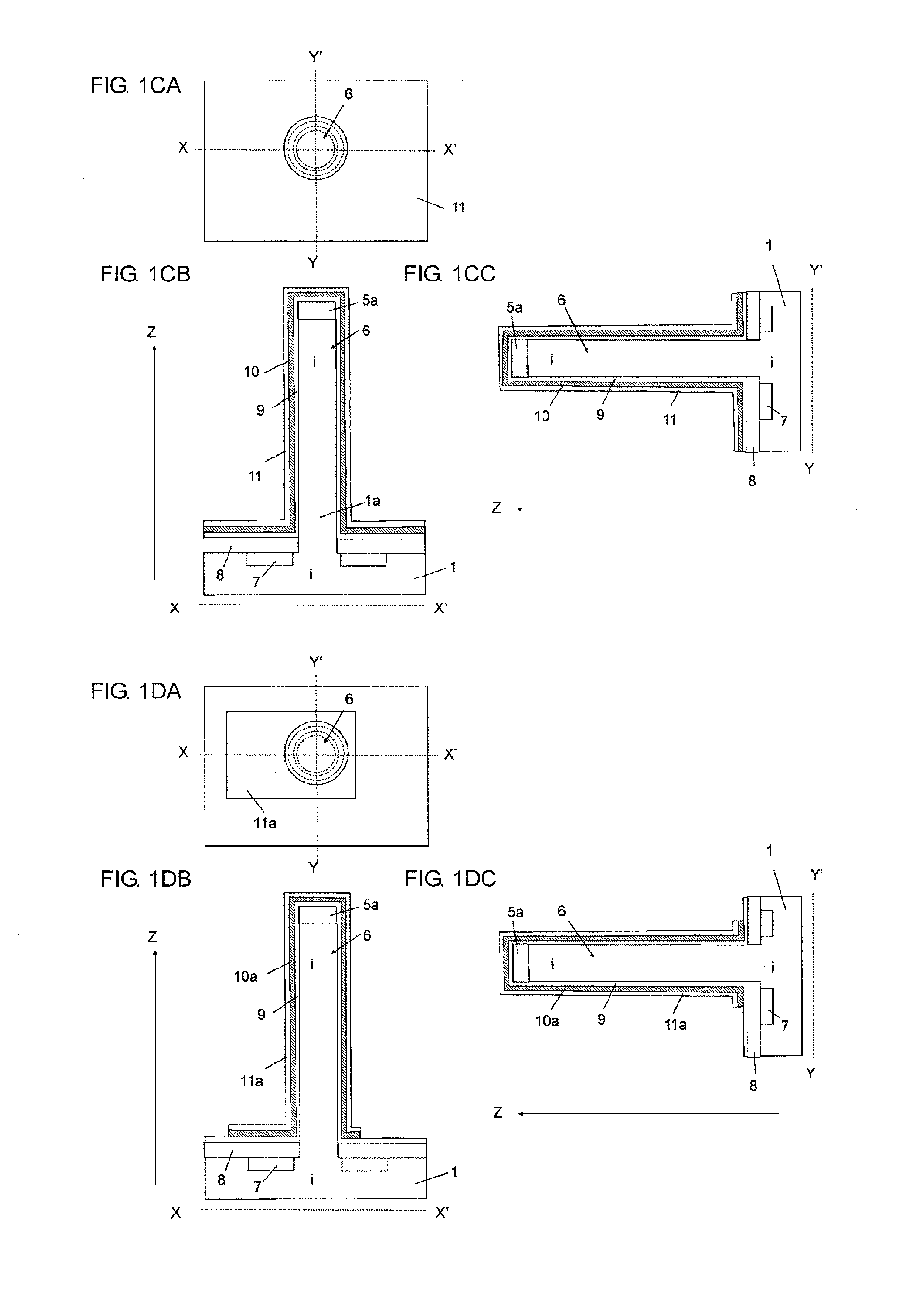Pillar-shaped semiconductor device and method for producing the same
a semiconductor device and pillar technology, applied in semiconductor devices, basic electric elements, electric devices, etc., can solve the problems of bending and collapse of the si pillar, and achieve the effect of accurate and easy formation
- Summary
- Abstract
- Description
- Claims
- Application Information
AI Technical Summary
Benefits of technology
Problems solved by technology
Method used
Image
Examples
first embodiment
[0054]Hereinafter, a method for producing a CMOS inverter circuit including an SGT according to a first embodiment of the present invention will be described with reference to FIG. 1AA to FIG. 1LC.
[0055]FIGS. 1AA to 1AC are a plan view and sectional views for explanation of a first production step of a CMOS inverter circuit including an SGT: FIG. 1AA is the plan view, FIG. 1AB is a sectional structural view taken along line X-X′ in FIG. 1AA, and FIG. 1AC is a sectional structural view taken along line Y-Y′ in FIG. 1AA. Regarding numbering of these drawings, the same relationship among the suffixes A, B, and C applies to other drawings that will be referred to below.
[0056]As illustrated in FIGS. 1AA to 1AC, a SiO2 layer 5 is formed by thermal oxidation on an i-layer substrate 1.
[0057]Subsequently, as illustrated in FIGS. 1BA to 1BC, the SiO2 layer 5 is etched by lithography and RIE (Reactive Ion Etching) to thereby form a SiO2 layer 5a. In addition, RIE using the SiO2 layer 5a as a m...
second embodiment
[0083]Hereinafter, referring to FIG. 2AA to FIG. 2B, a method for producing a CMOS inverter circuit including an SGT according to a second embodiment of the present invention will be described. The CMOS inverter circuit according to the second embodiment is produced by the same steps as those illustrated in FIG. 1AA to FIG. 1LC in the first embodiment except for the following difference in the structure.
[0084]In this embodiment, instead of the NiSi layers 31a and 31b, as illustrated in FIGS. 2AB and 2AC, a NiSi layer 32 connected to the side surfaces of the NiSi layers 20aa and 20bb is formed in the side surface of the Si pillar 6. A contact hole 28e is formed such that the bottom surface thereof is at the surface of the SiO2 layer 17aa. The contact hole 28e is used to mutually connect the output wiring metal layer Vout and the NiSi layer 20bb.
[0085]FIG. 2B is an enlarged view of a dotted rectangle B in FIG. 2AB. The silicide formation from the NiSi layers 20a and 20b into the Si p...
third embodiment
[0087]Hereinafter, referring to FIG. 3AA to FIG. 3BC, a method for producing a CMOS inverter circuit including an SGT according to a third embodiment of the present invention will be described. The CMOS inverter circuit according to the third embodiment is produced by the same steps as those illustrated in FIG. 1AA to FIG. 1LC in the first embodiment except for the following difference in the structure.
[0088]After the same steps as in FIG. 1AA to FIG. 1FC are carried out, as illustrated in FIGS. 3AB and 3AC, heat treatment is carried out to diffuse As atoms in the N+ region 7 into the i-layer substrate to thereby form an N+ region 7a. Subsequently, bias sputtering, for example, is carried out to direct Ni atoms in a direction perpendicular to the upper surface of the i-layer substrate 1, to thereby form a Ni layer 15a on the SiN layer 12a and form a Ni layer 15c on the Si pillar 6. Subsequently, bias sputtering is carried out to form a poly-Si layer 29a not containing impurity atoms...
PUM
 Login to View More
Login to View More Abstract
Description
Claims
Application Information
 Login to View More
Login to View More - R&D
- Intellectual Property
- Life Sciences
- Materials
- Tech Scout
- Unparalleled Data Quality
- Higher Quality Content
- 60% Fewer Hallucinations
Browse by: Latest US Patents, China's latest patents, Technical Efficacy Thesaurus, Application Domain, Technology Topic, Popular Technical Reports.
© 2025 PatSnap. All rights reserved.Legal|Privacy policy|Modern Slavery Act Transparency Statement|Sitemap|About US| Contact US: help@patsnap.com



